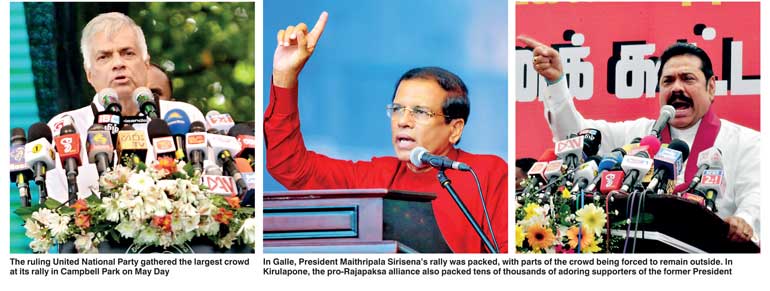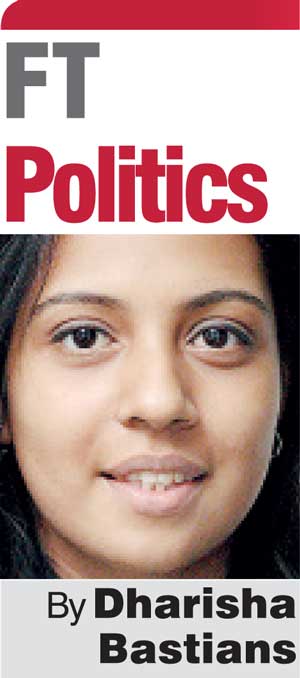Thursday Apr 18, 2024
Thursday Apr 18, 2024
Thursday, 5 May 2016 00:10 - - {{hitsCtrl.values.hits}}
 After the success of his dissident May Day rally that drew huge crowds to Kirulapone at the beginning of the week, former President
After the success of his dissident May Day rally that drew huge crowds to Kirulapone at the beginning of the week, former President

and Kurunegala District lawmaker Mahinda Rajapaksa was on the receiving end of a rude shock on Monday (2) morning.
Hundreds of buses had entered the capital Colombo from remote districts across the island carrying thousands of supporters eager to see the back of the Sirisena administration and ensure Rajapaksa is re-anointed king and commander-in-chief. The Baseline Road and High Level Road, strewn with piles of litter, were testament to the success of the pro-Rajapaksa rally.
The ruling United National Party gathered the largest crowd at its rally in Campbell Park on May Day, with Police estimating a crowd of nearly 80,000 in attendance. A reinvigorated base turned out to prove that in spite of nearly 20 years in opposition, the UNP remains the country’s single largest political party.
The two SLFP rallies saw their crowds split almost down the middle. In Galle, President Maithripala Sirisena’s rally was packed, with parts of the crowd being forced to remain outside the grounds. In the slightly smaller grounds in Kirulapone, the pro-Rajapaksa alliance also packed tens of thousands of adoring supporters of the former President.
The competition for the show of force by the de jure and de facto leaders of the Sri Lanka Freedom Party at May Day 2016 seemed to end in a tie. Mahinda Rajapaksa, who has pledged his commitment to an undivided SLFP, had led some 40 party men to rebel against their Party Leader and President. The separate May Day rallies finally ended the pretence.
Every attempt by President Sirisena to unify his party under his own chairmanship is failing. A large contingent of the elected SLFP MPs remain convinced that Mahinda Rajapaksa is their only hope for political survival. There is no more denying that the SLFP is on  the verge of a major split and deeply mired in internal crisis.
the verge of a major split and deeply mired in internal crisis.
The very day after the contentious May Day rallies, the Government struck back. It unceremoniously withdrew some 102 soldiers assigned to the former President’s security detail and replaced them with Police officials and Special Task Force personnel trained in VIP security. The STF, an elite force, falls within the jurisdiction of the Police Department. The Government has argued that even President Sirisena and Prime Minister Ranil Wickremesinghe are provided personal security by the Police and STF.
The former President and his loyal Joint Opposition are screaming blue murder about the withdrawal, insisting that the Government has endangered his life and demanding the reinstatement of the soldiers. The furore over Rajapaksa’s security on Tuesday resulted in the worst brawl in Parliament since 2004, with several MPs sustaining injuries in the scuffle between ruling party members and the Joint Opposition.
Longstanding security fears
Since his defeat in the January 2015 presidential poll, Rajapaksa and his younger brother and former Defence Secretary Gotabaya have revelled in the large contingents of Army personnel assigned to their security details. The former President had even adopted the practice of ‘loaning’ the members of his Army detail to his sons.
Hambantota District MP Namal Rajapaksa walked into a SLFP meeting in Angunakolapelassa last year with an Army Corporal in tow as his personal bodyguard. As a MP, Rajapaksa the younger is only entitled to a security detail comprising two MSD officials. This is the allocation for all MPs who do not hold ministerial office.
In April 2015, the Corporal, who was a member of the elite Commando regiment assigned to VVIP security details, was found with a pistol on his person and only meters away from President Maithripala Sirisena. Suspicions at the time were that the Corporal was well known to the Presidential Security Division, which has remained largely unchanged since the collapse of the Rajapaksa regime, and was therefore not body-searched before he entered the secure perimeter. An ASP of the PSD was also arrested in connection with the major security lapse.
Concerns about the Rajapaksas and their connections to the military have continued to plague the Government even one year later. When Gotabaya Rajapaksa was at the helm of the of the defence establishment, he turned military structures into a juggernaut, spanning the length and breadth of the State and ensuring its footprint in every sphere of public life.
The deconstruction of these structures has taken the new administration much longer than it should have. Their gradual decline from prominence in all matters of State has undoubtedly angered sections of the military establishment and exposed them to prosecution and accountability for certain illegal acts committed in recent years – potentially such serious abuses as enforced disappearances and even scribe killings – which may have been perfectly kosher during the tenure of the previous regime. This consternation has manifested in different ways over the past year.
Long shadows
When the controversial Bodu Bala Sena monk Galagodaththe Gnanasara stormed into the Homagama Magistrate’s Court during the Prageeth Ekneligoda disappearance case in January, his arrest was ordered on charges that included intimidating a witness and contempt of court. In response to the arrest order, mobs of monks and lay people laid siege to the Court house, hurling abuse at the Magistrate and accusing the Court of high treason for daring to act against the Buddhist monk.
Subsequent Police inquiries into that incident revealed the hand of military intelligence in that mass demonstration. CID investigations into the Ekneligoda disappearance have led to the Giritale Army camp and the arrest of several military intelligence officials. A strong pushback regarding the controversial case from these sections of the defence establishment nearly resulted in the transfer of the State Counsel in charge of the Ekneligoda case by the Attorney General’s Department in February this year, shortly after the incident involving the Bodu Bala Sena monk. The move was scuttled when news of the attempted transfer leaked ahead of time.
Subsequently, in March this year, a suicide jacket, a stock of explosives and ammunition were discovered by the Police in a house in Chavakachcheri in the Jaffna District. The discovery was based on a tip-off and Police arrested the house-owner soon afterwards. The discovery set off a chain of controversial events, including hysteria from the Rajapaksa camp who claimed it was proof positive of resurgence by the LTTE and the endangering of national security by the Sirisena-Wickremesinghe administration.
A spate of arrests has followed the discovery of the explosives in Chavakachcheri, creating ripples among the human rights community which is concerned the Government may be resorting to old tactics to keep State repression alive in the Tamil-dominated Northern and Eastern Provinces. And then last week, Police Spokesman ASP Ruwan Gunesekera, out of a job after his media unit was shut down by the IGP, made the startling revelation that at least three ex-LTTE cadres arrested in connection with the Chavakachcheri explosives were partially rehabilitated military informants.
 Military connections
Military connections
Ram, Nagulan and Thalayam were arrested in Batticaloa, Jaffna and Trincomalee respectively and Police investigations found the trio were working with the military intelligence at the time of their arrest. The fact that the trio worked closely with the military was well known among the local populations in their areas.
“People would stop talking when these former cadres walked into a room. It was a well-known fact that these men were Army informants and the local people were wary of them,” one source on the ground in Jaffna told Daily FT, confirming remarks by the Police Spokesman.
The revelation poses several problems. Firstly, the arrests were made in connection with the explosives cache found in Chavakachcheri at the end of March. If these ex-Tigers are suspected of involvement in planting the explosives, were they working alone or did they have the tacit approval of their handlers? Potentially handlers who may be feeling somewhat abandoned, isolated and stripped of their importance in post-Rajapaksa Sri Lanka.
The fears created by this extraordinary turn of events feed into an ongoing problem the Sirisena-Wickremesinghe Government has had with winning the allegiance of sections of the security establishment. Concerns about a top tier military leadership loyal to the Rajapaksa regime was dealt with delicately, over the course of nearly a year. Over time, the Government has managed to phase out senior military officials with the strongest affiliations with the former President and Defence Secretary.
In some way this transition is also about changing mindsets within the military, restoring it to its appropriate place as subordinate to the civil administration. But the task of determining the affiliations of the mid-command tiers and determining how far these affiliations can push these officers to act against the Government has proved to be trickier.
A new light
It is in this light that the Government’s decision to completely withdraw the Army units providing security to former President Rajapaksa must also be examined. Undoubtedly, there is a major political motivation in the move, but also possibly an underlined fear about how the Rajapaksas will choose to wield the soldiers within their sphere of influence, especially if they begin to feel that their political star is on the ascent once more.
The Government policy to transfer VIP security responsibility to the Police Department almost exclusively speaks to the concerns at higher levels of Government, which could be prompting a gradual shift away from the militaristic state. The process is beyond delicate, Government officials say. Senior Government leaders are aware of the volatility renegade units of the deep state could create if allowed to operate freely.
The current Government is often criticised, and justifiably so, for ruling with the Rajapaksa monkey on its back. For too long, the long shadows cast by the former President have paralysed the new administration and makes it fearful of overstepping as it struggles to deliver progressive reform. And even though the potential of a Rajapaksa resurgence remains remote, the former President has managed to keep himself in the headlines and politically relevant one year after he suffered two humiliating election defeats.
The elections may have stripped him of power, but his ability to harness popular support remains intact. More importantly, one year after his defeat, his national security credentials remain largely unhurt by the polls losses. In the still unlikely event of a security lapse or violent incident, the clamour for the Rajapaksas and a return to the garrison state will reach fever pitch. Already, with a weak-on-security UNP in power, the arrest of military informants is raising concerns about a repeat of the Athurugiriya Millennium City fiasco in 2002.
Paranoia about the Rajapaksa spectre politically is easily dismissed. The security dimension has been and is a much more serious matter and has more to do with reining in – with great care – a monster the former regime unleashed, preferably without losing a hand in the process.
To tread lightly, while treating the threats with all the seriousness it deserves, would be the Government’s wisest course. And meanwhile, instead of fighting shy and playing defence, the Sirisena-Wickremesinghe administration would do better to chart its own political path; one as diametrically opposed to the politics of the Rajapaksas as possible; that puts inclusivity, transparency and democratic reform at the core of its political value system. A system that can ultimately win over still unconvinced sections of the bureaucracy and the military that there is a style of governance that is wholly different from authoritarianism and family bandyism – and that it can also work, and work better.